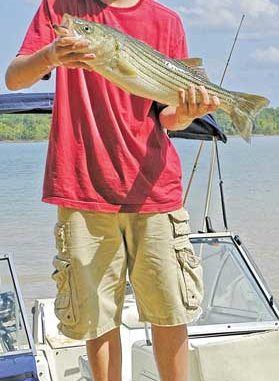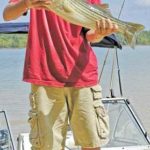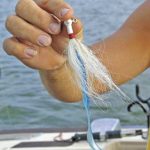
Biologists say decent-size stripers still live in Kerr Reservoir, but anglers must first wade through juvenile fish.
It was typically hot and steamy on July 19, 2008, at John H. Kerr Reservoir, a 50,000-acre Army Corps of Engineers lake along the North Carolina-Virginia border.About two dozen friends had gathered at a shoreline dock near the Hibernia Recreation Area. They had met to hold a striped bass tournament/picnic in honor of Albert Madden, aka “Mountain Man” and his wife, Vera.
Madden had been one of the first fishermen to figure out how to fish effectively for striped bass in Kerr, descendants of the stock that’d been trapped when the dam’s gates were closed in 1953.
An anadromous species that lives part of its life in freshwater and part in saltwater, stripers had traversed the Roanoke/Staunton/Dan River systems since before Sir Walter Raleigh landed his first set of colonists on Roanoke Island in 1587.
But the U.S. Army Corps of Engineers — in fact, no one — had predicted the dam’s closure would trap “rockfish” at Kerr (aka “Buggs Island”). Moreover, no one had figured the landlocked fish could survive and thrive in a total freshwater environment. But the two main systems feeding the lake — the Staunton/Roanoke and Dan rivers — provided enough upstream distance (60 miles) to allow stripers to spawn successfully each year and keep the lake well populated.
But few people knew how to catch them almost 50 years ago. Then things began to change in the 1960s with the arrival of anglers such as Madden.
“Guys kept getting their bass (fishing) tackle tore up,” he said, “by these big fish that broke lines like threads. Once in a while, somebody’d accidentally land a striper that’d hit a crankbait or topwater lure while they were pluggin’ a point in the morning or evening.
“I lost spinnerbaits that were broken in half or mangled by stripers, and Vera had stripers straighten the hooks on Torpedoes (topwater prop baits) more than once.”
Later in the 1960s and during the 1970s, Madden and his friends discovered the lake’s stripers would hit deep-trolled plugs during the summer, at depths where they were seen on the first Humminbird and Lowrance flasher-unit fish-finders.
“We didn’t know what we were doin’ to start out,” Madden said with a laugh. “We thought by trolling big-lip Rebels and letting out a lot of line, we were trollin’ deep. It took us several years to figure out the line was just bowing, and we might have out 200 yards of line, but the lure would be running only about six feet deep.”
Even at that, Madden said he and other regulars — Steve “Termite” Fogleman, Darrell “Bojangles” McLendon, Gerald Barbour and Roger, Peggy and Cathy Overman — managed to catch rockfish from 15 to 25 pounds.
They also discovered lead-core line, flasher units and planers provided the edge they needed to catch deep summertime rockfish.
“Back then, we trolled from four to eight lines at once,” Madden said. “There was a boy called ‘Red Bomber’ who had so many lines out, his boat looked like a water spider.”
Once they found a big school of shad on their flasher units, some anglers preferred to jig 1-ounce square-head or butterbean-type bucktails (usually white, yellow or chartreuse) with wooly-worm trailers.
Some discovered cast-netted shad, drifted across creek channels and “hurdles” would catch fish. But that technique wasn’t much fun during July when temperatures sizzled above 100 degrees, and the lake reflected sunlight off its surface like BB shot bouncing off a tin roof. At least when trolling, anglers could stir up a breeze to make bearable such fishing.
“We sometimes filled the bottom of (his boat) with stripers, iced ’em down and took ’em home,” Madden said. “This was before there was any (daily) limit.”
The reservoir didn’t have size and creel limits on striped bass until 1976. Today, the limits are four fish of at least 21 inches per person per day.
Jim Ward, a retired North Carolina wildlife enforcement officer, has said Kerr Lake’s striper numbers once were so vast it was like fishing on the ocean.
“Before they started taking so many stripers out of there, it was like being at the ocean and seeing a school of bluefish come up,” Ward said. “You could be out on the lake in the early morning or evening, and you’d have schools of stripers covering acres come up to chase shad. Throw a topwater lure, any kind of lure, and you could have a really good time.”
Madden, who camped at state recreation areas and was a member of two private camping clubs, hasn’t fished much at the big lake since the early 1990s.
Just as well. Although the lake apparently is slam full of striped bass, they’re on the small side. A 7-pounder is considered a nice one. During the halcyon 1960s, 70s and 80s, a 7-pounder would be considered too small and released alive.
Steve Fogleman was one of the organizers of the 20th Mountain Man Kerr Lake Striper Tournament and one of its anglers. He’s never wavered in his enthusiasm for fishing for striped bass at the lake, mainly because of his son, Todd, and grandson, Steven. But he said he’s watched the quality of fish slowly deteriorate.
“I’ve been fishing the lake since the late 1970s,” he said. “Back then, there were fish everywhere, and all the big fish you cared to catch.”
McLendon said he remembered in the early days, the 1960s, someone landed a 50-pounder.
“I think it was one of the original stock that had been trapped in the lake,” said McLendon, a Burlington native who owns a house at the lake and is a guide. “Several big fish in the 40- and 50-pound range were caught right after people started fishing. But soon, fish that size were gone.”
Fogleman believes fishing pressure changed the quality of Kerr’s striped bass.
“When people discovered the lake had a lot of stripers, they started flocking here in the 1980s,” he said. “They took a lot of stripers out of the lake — legally. Then there were those guys who used trot lines and gill nets and sold ’em illegally. They did that for years before the Wildlife (Commission) and Feds (U.S. Fish & Wildlife Service) did a sting and caught most of ’em. But it seemed like to (recreational anglers), they let that go on for too long. There’s no telling how many thousand pounds of stripers were taken out of Kerr Lake before they put a stop to it.”
Ward, the lead Commission agent in “Operation Rock,” the 1980s sting that ended striper poaching on the Roanoke River system, said most of the illegally-caught fish were taken by hook-and-line anglers, recreational guys who’d make three or four trips to the lake per day and could land more than 200 pounds to sell at $2 per pound.
Still, since that era, the lake has had time to recover, and it is regularly stocked with striper fingerlings.
Fogleman and most of the anglers in “Madden 2008” don’t use live bait. In the 1960s and ’70s, they learned from Madden how to troll artificial lures deep with planers. They’d scour the lake, looking for baitfish pods — big bunches of threadfins and gizzards, which made flasher units light up like Christmas trees — that almost always had stripers underneath them. It was a simple matter to let out enough line to allow planers, with 10-foot leaders and bucktails or combo rigs of bucktails and big Rebels, down to the depths where larger “marks” (stripers) showed on the screens.
“Sometimes you’d go through a school, and all four rods would go off at once,” Fogleman said. “That was a lot of fun. And you often hooked up with fish of the same size; stripers about the same size liked to school together.
“My best striper was a 19¾-pounder, but we caught many 18-pounders back then and a bunch of 15s and 16s.”
Today he trolls 3/8-ounce white bucktails, because the stripers are smaller.
“I don’t use a Wooly Worm any longer,” said Fogleman, who bought a camper and placed it on some private land near Hibernia in 1983. “I think (the fish) might have gotten used to seeing that. I like a 7½-inch blue curlytail plastic worm as a trailer on bucktails.”
When Kerr’s average striper seemed to begin shrinking about four or five years ago, Fogleman said he thought copepods — gill maggots or gill lice” — had migrated downstream from Smith Mountain Lake. At Smith Mountain, the little beasties — they appear similar to grains of white rice — showed up in 2002, settled in the gills of striped bass and contributed to a massive die-off of large stripers in 2003.
“We figured these same parasites killed a lot of Kerr’s fish,” Fogleman said. “The bigger fish (in Kerr) must have been stressed out when the (copepods) got in here. It was common for a while to see dead stripers floating all over the lake with parasites on them.”
But during the last few years the lake’s striper population has rebounded, he said.
“Since they changed the lake’s striper size limits, I think it’s helped things,” Fogleman said. “Also, our guys are trying to encourage people, if they catch four fish in the summer, to quit for the day.”
Kevin Loy who competed in the Mountain Man tourney, likes a different approach: live-bait fishing of the type done at Santee-Cooper.
“I’ll go to the (river) channel, anchor and put out shad, gizzards or threadfins or alewives,” he said. “I use an 18-inch leader with a clip-on swivel and a circle hook. I clip the leader on the (weighted) line, and that allows the baitfish to swim up and down. I just fan-cast out six or seven baited lines, put them in the rod-holders and sit and wait for stripers to come along.”
Even with the smaller fish, Fogleman, Loy and other anglers at the Mountain Man tournament said they continue to return to Kerr Lake to sample its rockfish.
“I think there’s bunches of stocked fish in the lake right now,” said Fogleman. “We’re catching lots of 25-inch stripers each year; that means they’ll be keepers next year and after that.
“One good thing — because the sizes are small, it means not as many people are crowding the lake these days. I enjoy the habitat up here, too; it’s still a lot of fun, a great place to bring kids and teach ’em to fish.
“And the fishing for stripers should just get better and
better.”










Be the first to comment